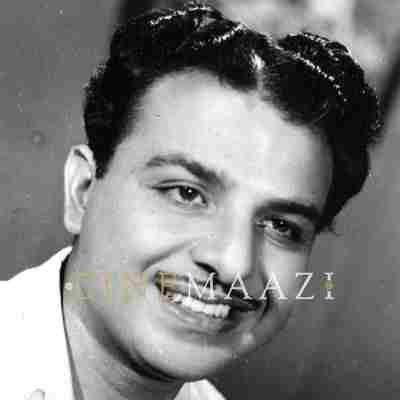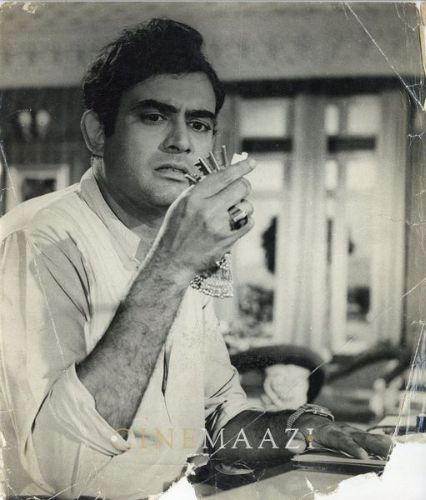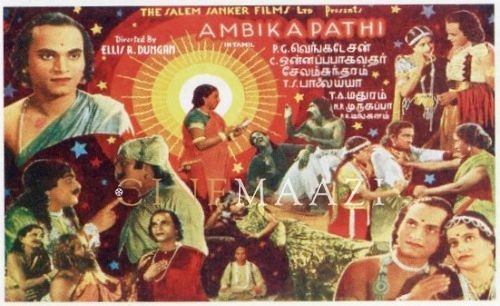This section is for paid subscribers only. Our subscription is only $3700/- for one full year.
You get unlimited access to all paid section and features on the website with this subscription.
Subscribe to read full article
This section is for paid subscribers only. Our subscription is only $37/- for one full year.
You get unlimited access to all paid section and features on the website with this subscription.
Not ready for a full subscription?
You can access this article for $2, and have it saved to your account for one year.
- Release Date11/12/1937
- GenreHistorical, Drama
- FormatB-W
- LanguageTamil
- Run Time210 min
- Length5791.2 meters
- Censor RatingU
- Censor Certificate Number1010A
- Certificate Date09/12/1937
This film is about the famous poet Ambikapathi (son of famous poet Kambar, who wrote the most popular ‘Kamba Ramayanam’) and his love for Amaravathi, daughter of the Chola King (Uraiyur) in 1083 AD.
The story is set in Uraiyur of the Chola Empire in 1083 A.D. Ambikapathi (M.K. Thyagaraja Bhagavathar), son of the Tamil poet Kambar (Serugulathur Sama), goes on war against the Kalinga kingdom under king Kulothunga Chola (P.B. Rangachari) and saves the king’s life. The Chola army wins the war and returns successfully to Uraiyur. King Kulothunga rewards Ambikapathi with a special sword for his bravery in the war. Army commander Rudrasenan (T.S. Balaiah), jealous of Ambikapathi, invites him for a ‘friendly’ sword fight. During this sword fight, Chola’s daughter Amaravathi (M.R. Santhanalakshmi) observes Ambikapathi’s bravery and beauty and falls in love with him. He wins the fight and loses his heart to her.
Ambikapathi and Amaravathi meet secretly in the palace. His father Kambar cautions him about this love and asks him to forget her as she belongs to the royal family while they are poor. However, Ambikapathi expresses his inability to forget her as he is deeply in love with her. During the Krishna Jayanthi celebrations in the kingdom, several poets are invited to the palace. Ambikapathi also comes and meets Amaravathi secretly inside the palace. The King, who had information about their love, catches them red-handed and sentences Ambikapathi to death. Poet Kambar pleads for his son’s life. As recommended by another poet Koothar, the king challenges Ambikapathi to sing a hundred poems on the subject of ‘puram’ (war and politics). The poems should not have any reference to ‘aram’ (love and romance). If he succeeds, Amaravathi will be married to him; if he fails, he will face death. Ambikapathi takes the test in the King’s court with a Kadavul Vaazhthu (invocation to God). Amaravathi, who is counting, mistakes the invocation as a poem and counts it as the first poem. When he has sung 99 puram poems, she thinks he has completed the task of 100 poems and opens the screen to wish him.
Seeing her and assuming 100 poems were completed, Ambikapathi sings in praise of her beauty (aram) through the song, ‘Satrey Sarindha Kuzhaley Thuvala…’ and thus fails the test. Despite Kambar’s pleas, the
King orders Ambikapathi’s death. When the soldiers try to kill him with a sword, it becomes a garland on Ambikapathi. The King gets angry, thinks it is a trick by Ambikapathi and personally stabs him to death. Amaravathi also dies on seeing Ambikapathi die. The lovers unite in heaven and become immortal in their love.
The film was a huge success and ran for 52 weeks. Dungan’s elegant portrayal of love scenes, Bhagavathar’s singing and Elangovan’s dialogues made it the most talked-about and successful film.
After Chintamani, this was Bhagavathar’s second hit film in 1937 making him the first superstar of Tamil Cinema.
Dungan, who did not know Tamil, used Shakespeare’s Romeo and Juliet as inspiration for this film and incorporated some of its scenes in the script. The film’s writer was the Tamil scholar Thanigachalam, whose pen name was Elangovan. He translated the scenes Dungan had marked out from Shakespeare’s play into Tamil and incorporated them in this film.
The film was made in the New Theatres studio in Calcutta and the background music was composed by the blind singer-composer K C Dey. Another high point of the film was its music, written and composed by Papanasam Sivan. The voice of M K Thyagaraja Bhagavathar, who, as Ambikapathi, sang a number of songs including the famous Bajanai seivai maname, was a major attraction. This film proved a landmark in his career.
The film opens with the scene of Kulothunga Cholan returning victoriously from battle. His entry into the city of Woriur was filmed quite spectacularly. In fact, such scenes depicting groups of people moving in the open was a favourite with Duncan. Sage Kanwar returning from his pilgrimage in Sakunthala and the marriage party returning home in the film Mandhirikumari are other examples from his work.
The film had many super hit songs by Papanasam Sivan rendered beautifully by MKT. Popular among them were, ‘Jaya Jaya Senthamizhnadu (title song)...’, ‘Ini Evvaru Marappen Vazhvil…’, ‘Ulaginil Inbam Verundo…’, ‘Enna Seidhai Nee En Arumai Magane…’, ‘Mane Unnai Adaya Naan Enna Thavam Seidhen…’, and ‘Ayakkalaigal arubathi nanginayum…’
The importance given to dialogue set this film apart from the others made in the Thirties in which songs dominated. Ilangovan, the scriptwriter, started this trend and was evident both in the balcony scene and in the one where the friend of the princess brings a message from Ambikapathi-in which he had borrowed liberally from Shakespeare. Mumbai based filmmaker Karan Bali has produced a documentary on the life and works of Dungan titled “An American in Madras”.
Cast
Crew
-
BannerShankar Films, Bombay
-
Director
-
Producer
-
Music Director
-
Lyricist
-
Story Writer
-
Screenplay
-
Dialogues
-
Cinematography
-
Editing








.jpg)




